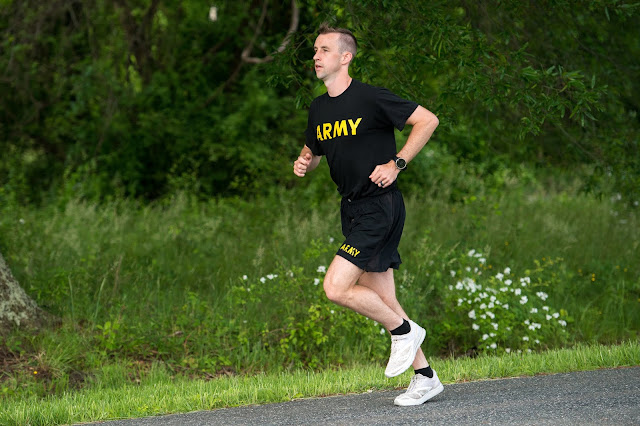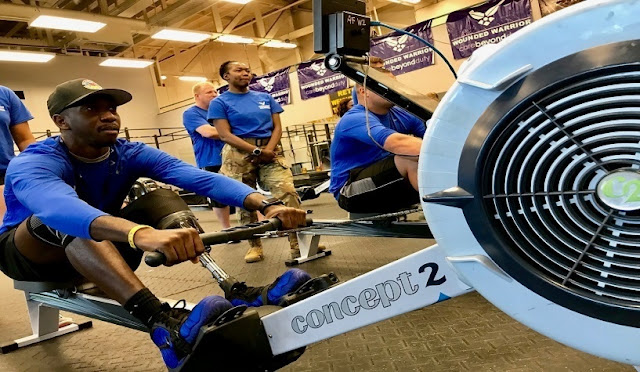Army public health experts offer training tips for Army Ten-miler participants
Story by Douglas Holl
Army Public Health Center
“You can do it,” said Army Maj. Timothy Benedict, an APHC physical therapist who specializes in injury prevention. “Come up with a progression plan and be confident that many people just like you have far exceeded what they thought was possible. The human body is incredibly resilient.”
Training for the Army Ten-miler starts with incorporating the Performance Triad into your training routine, said Benedict. P3 focuses on sleep, activity and nutrition intertwined to enhance every runner’s performance.
Sleep is critical for performance and is needed to rejuvenate, said Benedict. Focus each night with seven to eight hours of sleep and keep a regular sleep schedule with a consistent bed and wake-up time.
Activity is the next tenant of P3 and Benedict says a three to five month progressive training schedule is plenty of time to prepare for the 10-miler. Benedict has developed a training schedule (linked to this article), adapted from the Runner’s World Big Book of Marathon and Half-marathon Training, with a 20-week or 10-week progression.
“To help with motivation, think about signing up with a local running group or convince a friend to join you,” said Benedict.
Benedict, who is also an experienced distance runner and ten-miler veteran, says inexperienced runners should give themselves at least 12 weeks of training to give their bodies time to adapt to the distance and also allow them to vary their mileage, reducing mileage every fourth week.
A good training regimen will include three to four runs per week, said Benedict. A “long” run, a “medium” run, and interval training.
“Incorporate strength training and gradually increase your mileage for your weekly long run, and ramp back down for a relatively easy run every fourth week or so.”
How long is long? Both the 10-week and 20-week recommended training schedules start with a shorter 2-4 mile run during the week followed by a longer run on weekends, progressing from 2-8 miles and back down to 3 miles on easy weeks.
“Your long runs should be at a one to two minute slower pace per mile than your short run pace to build up your endurance,” said Benedict. “This applies even if you are walking up hills and running on the flats and downhills.”
To avoid injuries while training, APHC Kinesiologist Tyson Grier recommends comfortable running shoes and said overuse injuries can be avoided by incorporating sprint training or high intensity interval training during the week to offset weekly distance running.
“Interval training is running fast for one to four minutes, then recover at a light jog for an equal amount of time,” said Grier. “You can use mailboxes or telephone poles as your intervals.”
Grier suggests adding one or two days of strength training to the training plan and one or two additional runs per week in between, with an easy pace and at low distances.
Benedict also recommends using tempo runs for training. A tempo run is a pace a runner can maintain for an hour, not a runner’s fastest pace.
“Start with a warm up for five minutes and then transition to a faster run for five to 10 minutes and slow down for five minutes,” said Benedict. “Gradually increase up to 25 to 30 minutes at the faster pace.”
Fueling is also a critical part of every runner’s training regimen, said Joanna Reagan, an APHC registered dietitian nutritionist. Nutrition is the third tenet of the performance triad with target goals of building a healthy plate with lean proteins, fruits, vegetables, whole grains and dairy at each meal. Aim to make half of each plate fruits and vegetables each meal and choose water over sugary beverages.
“Eat a light breakfast before your long run,” said Reagan. “Focus on mostly carbs and some protein about 30 minutes before you run. Pick foods that are easily digestible.”
Some examples of good pre-long run fuel include a bagel with peanut butter, a banana, and an energy bar, or a bowl of cold cereal or oatmeal with a cup of milk, said Reagan.
“If you’ll be out for more than an hour, a sports drink or hydration drink mix will help to replenish electrolytes and provide around 6-8 percent carbohydrate,” said Reagan. “Practice with different brands to determine the best tolerance for you. Don’t try anything new on race day.”
Good hydration is also important. Reagan recommends not overhydrating the morning before a long run so “you don’t have to look for a pit stop along the way.”
Experts recommend drinking 16-24 ounces of fluid before each workout or race.
“On long-run days, plan to either carry water with you in a water bottle or plan a route that you can loop back to your car or home so you can pick up water and snacks,” said Reagan. “Make sure you are drinking water along the way.”
Benedict also recommends planning both a good warm-up and recovery or cool down with every run.
“A dynamic warm-up means slow, controlled movements that increase blood flow to the muscles and joints you will be using during your work-out,” said Benedict. “For instance: jogging in place, slow squats or lunges, or Army Physical Readiness Test preparation drills. Your warm-up does not need to last more than five to 10 minutes.”
For the cool down, Benedict recommends walking for 10 minutes to slow down the heart rate and help prevent soreness. This is also a good time to perform some stretches.
“Hold your stretches for about 30 seconds each” said Benedict. “You should feel gentle tension while stretching, no need to push through anything stronger.”
Nutrition is also an important part of recovery.
“Plan to have a snack of about 250 calories containing carbohydrates and protein within 30 minutes after finishing your run,” said Reagan. “It’s important to replenish your glycogen stores. Low fat chocolate milk is always a good choice as it has protein and carbohydrates.”
Benedict says picking the right running shoes and clothing is also a must for every runner.
“Ideally your shoes should be worn in for a couple of months before the race,” said Grier. “Practice wearing the right amount of clothes during training. Many runners heat up more when racing and will wear less clothing on race day. It also depends on the weather conditions, so check the weather forecast before training and on race day.”
The key to good training is not giving up, said Benedict.
“Don’t get discouraged if you have a hard week or two,” said Benedict. “It’s not a crime to walk at times. Your body will adapt and become more efficient at running. Just take it slow and give it time.”




Comments
Post a Comment